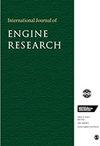基于停滞焓理论的新型船用涡轮增压器压缩机体积流量模型
IF 2.1
4区 工程技术
Q2 ENGINEERING, MECHANICAL
引用次数: 0
摘要
压缩机体积流量模型决定了模拟中流入柴油发动机的质量。它是影响柴油机整体性能精度的关键组件模型。目前,缺乏准确且易于使用的压气机容积流量模型。为了解决这个问题,我们提出了基于停滞焓的压缩机体积流量模型(SP 模型)。SP 模型与著名的简森经验模型的改进版 M-JENSEN (MJ) 和基于物理的 KS 模型进行了比较。所提出的 SP 模型只需要确定停滞压力。经验 M-JENSEN 模型需要压缩机图来优化其六个参数。基于物理的 KS 模型需要确定具体的工作。SP 模型所需的测量数据最少,且易于确定。在 ABB A270 上进行的模型精度比较显示,建议的 SP 模型可以生成 RMSE 约为 1.1m3/s 和平均相对误差 (MRE) 约为 6.9% 的压缩机图。ABB A270 的额定容积流量约为 20 立方米/秒。而 MJ 模型的 RMSE 和 MRE 分别约为 0.6m3/s 和 3.1%。而 KS 模型的 RMSE 和 MRE 分别约为 3.0m3/s 和 17.4%。将模型的精度与 MAN TCA88 进行比较时,SP 模型的性能略好于其在 ABB A270 上的性能。MAN TCA88 的额定流量约为 60 立方米/秒。SP 模型、MJ 模型和 KS 模型的均方根误差值分别为 3.2m3/s、2.2m3/s 和 10.3m3/s。它们的 MRE 分别为 6.73%、4.45% 和 17.8%。从这些结果可以得出结论,我们提出的 SP 模型需要的数据最少,易于编码,性能卓越。它是迄今为止柴油机实时仿真中最好的压缩机质量流量模型之一。本文章由计算机程序翻译,如有差异,请以英文原文为准。
A novel marine turbocharger compressor volume flow rate model based on stagnation enthalpy theory
The compressor volume flow rate model determines the mass flowing into the diesel engine in simulation. It is a key component model that affects the accuracy of the overall performance of the diesel engine. At present, there is a lack of an accurate and easy-to-use compressor volume flow rate model. To solve this, the stagnation enthalpy-based compressor volume flow rate model (SP model) is proposed. The SP model is compared with an improved version of the famous empirical JENSEN model, M-JENSEN (MJ), and physics-based KS model. The proposed SP model only requires the stagnation pressure to be determined. The empirical M-JENSEN model needs a compressor map to optimize its six parameters. The physics-based KS model requires specific work to be determined. The SP model needs the least measured data and is easy to be identified. Models’ accuracy comparison on ABB A270 shows that the proposed SP model can generate the compressor map with RMSE of about 1.1m3 /s and mean relative error (MRE) of about 6.9%. The rated volume flow rate of ABB A270 is about 20m3 /s. While the RMSE and MRE of MJ model are about 0.6m3 /s and 3.1% respectively. And they are about 3.0m3 /s and 17.4% for KS model. When the model’s accuracy is compared to MAN TCA88, SP model shows slightly better performance than its performance on ABB A270. The rated volume flow rate of MAN TCA88 is about 60m3 /s. The values of RMSE of SP model, MJ model, and KS model are 3.2m3 /s, 2.2m3 /s, 10.3m3 /s respectively. Their MREs are 6.73%, 4.45%, and 17.8% respectively. In terms of these results, it can be concluded that our proposed SP model needs the least data, easy to code, and has excellent performance. It is one of the best compressor mass flow rate models so far in real-time diesel simulation.
求助全文
通过发布文献求助,成功后即可免费获取论文全文。
去求助
来源期刊

International Journal of Engine Research
工程技术-工程:机械
CiteScore
6.50
自引率
16.00%
发文量
130
审稿时长
>12 weeks
期刊介绍:
The International Journal of Engine Research publishes high quality papers on experimental and analytical studies of engine technology.
 求助内容:
求助内容: 应助结果提醒方式:
应助结果提醒方式:


